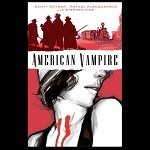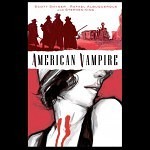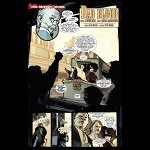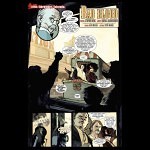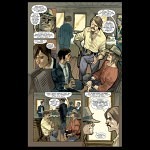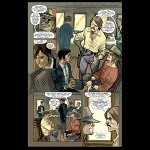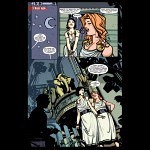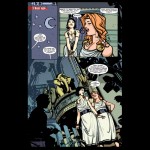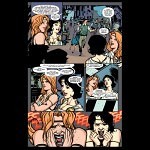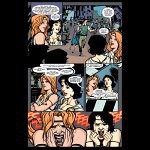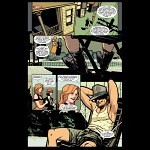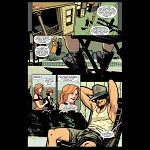I first spoke with Scott Snyder shortly after the release of his first written comic, a one-shot for Marvel issued last spring featuring the original Human Torch. Early in the book, the main character, an android coated in a layer of synthetic skin, is afflicted with a flesh-eating poison that requires his skin to be stripped off so his creator can grow for him a new one.
The scene could be a metaphor for the bulk of Snyder’s work, best illustrated by his short-story collection Voodoo Heart (Dial Press, 2006), whose characters, often due to their own action or inaction, seem to find themselves stripped of something vital which they can’t pull back from the depths of their loss.
In the years since Voodoo Heart — of which Stephen King said, “I couldn’t put it down” — Snyder has been teaching English at various colleges in New York and developing the concept that eventually became the plot of American Vampire, an original horror comic series which he has been collaborating on with King and which began as a monthly series from DC imprint Vertigo in March.
At the time our first interview was conducted by phone, American Vampire was still in the scripting stages and DC wouldn’t allow Snyder to give details. I caught up with Snyder by email shortly after the series’ first release to ask about the project, and the following interview integrates his comments with our previous discussion on the differences between writing comics and literary fiction, as well as his upcoming novel, The Goodbye Suit, due out in 2011 from Dial Press. The interview has been edited for length and clarity.
Tell me about American Vampire. What’s the concept?
It’s this central concept of vampire evolution. The series imagines that vampires are these physiological creatures that over time have evolved into different species, as the vampiric bloodline has hit different populations at different times throughout modern history. The idea is that every once in a while the blood randomly mutates and creates a new bloodline that branches off into a different species of vampire with different attributes. So the vampires we all know — the nocturnal, anemic, elegant, sun-fearing breed — are just one species. How that species came to be dominant is part of the secret of the series. More specifically, though, the series centers on this brand new species of vampire that’s accidentally created in the American West, almost a kind of Vampire 2.0. He’s stronger and has these unique characteristics that make him thrive in the sunlight and have different claws, different fangs, and different abilities and weaknesses, which are mysterious in the first issues as well. This first American Vampire — a wild, sociopathic outlaw in life named Skinner Sweet — is the focus of Steve’s story. My part is set in the 1920s, telling the tale of a struggling actress in the silent film industry named Pearl Jones, who has a run-in with some members of the undead.
Why did you decide to focus on vampires?
I came up with the idea several years ago, when I was in a hobby shop in the West Village. I was looking at the statuettes and figurines and there was this statue of an undead zombie Confederate soldier, and I started thinking how — being a big vampire fan — I’d never really seen vampires in settings that I loved, like some of the more iconic American landscapes: the Old West, the roaring ’20s, and so on. All the vampires at that time were like Blade and Underworld and Queen of the Damned, gothic and exotic and sleek, like on their way to some super-cool underground club scene or something. So I started thinking about how fun it would be to see vampires in the settings I liked, but vampires with a different character to them, something more animalistic and feral. Not so sophisticated and snobby.
How does the structure of the book now — with King writing Sweet and you writing Pearl in what are at the moment separate arcs –compare to your original vision for the book?
The series — and the characters, the stories — is exponentially better for Steve’s involvement. He built on what was there in the characters already, made them richer and more complicated, gave them compelling histories. And he took the story in his cycle to a totally dark and surprising and affecting place. As for working with him, it was a real inspiration. Watching him work is humbling, both for his imagination and his work ethic.
Is there anything in particular that attracted you to write a female protagonist in this series?
I thought it’d be fun to reverse that dynamic you see so much, the human girl in love with the dangerous male vampire. In all these things, you get some hunky vampire telling a human girl how special she is. I sort of just figured, why not have her be special by making her the vampire? And a new, more vicious kind.
How is writing comics different from writing literary fiction?
Literary fiction, I love it, but it’s you and a computer alone forever, in a room, and it sucks and there’s no way around that. I love it, my heart is always there and stuff, and I love it as much as I love the comics, but it’s a very lonely profession. There’s no collaboration until your whole draft is done, and what’s exciting about the comics is that not only do you have an editor that works with you at each stage if you want — so I can send it over when I have a few pages, like, “What do you think?” — but then when the artist comes in the cool thing for me, like with [The Human Torch], was I could [say], “Hey listen, let’s make your style work here. I don’t want to be like ‘three small panels’ if what you do really well is big, explosive panels. So you tell me: What do you want? And what do you think is a good idea for this page?” And sometimes you agree and sometimes you don’t, but the collaboration was just so exciting all of a sudden.
How does the visual aspect of comics affect the writing? How much control do you have over panel content?
That’s what’s so weird, man, you have total control. I had no idea. You literally script it like a movie script. First, I do an outline of the whole issue page by page, like, “This is what’s gonna happen.” I had to do that for the whole series [of American Vampire], the first six-issue cycle. So I’m like, “Here’s the first six issues, this is what’s gonna happen,” they approve it, and then I break it down into pages. So then I send back a thing that’s like, “On page one this needs to happen,” just a few lines per [comic book] page, and then that gets approved and then you script it. I had no idea till I did the “Torch” that you can tell them exactly what you want. So you’ll say, “Page one, three panels, large panoramic shot of the American West,” and then, “Panel two, introduction to this character.” You write in the dialogue like a script. But you can say like, “High angle close on his eyes,” and the artists follow that.
How is all the comic work meshing with your fiction work? How’s the novel coming along?
I’m hoping to have a draft done this summer. The funny thing is my publisher was really, really excited about all the comic work and seemed [to be] very happy to let me work on that and to sort of split my time a little bit right now. There’s such huge crossover between the literary audience and the comic audience; there’s just a lot more crossover between Neil Gaiman and all these guys that are suddenly getting strange recognition in both worlds. [That] the audience follows you back and forth between mediums is what they’re realizing, so it’s interesting because it’s just an exciting time to be a writer if you enjoy that sort of stuff.
For me, I really did honestly come to storytelling and writing through comics; I grew up as a total comic geek. I love literary fiction and I love it just as much as I love comics, but I guess the idea is you start to realize there doesn’t have to be any real line. You can be writing a literary book that has comic elements — and there’s so much evidence of that over the last five or six years, some of the books that have come out — and then you can be writing a comic book like [American Vampire] that for me is like a horror series — there’s a monster and stuff — but it’s also really about what it means to be American at these different time periods, too, and American identity. It has “American” in the title. It sort of gives you a chance to investigate these different historical periods through a genre in a fun way. So it jumps, like every six issues it jumps to another decade.
At what stage did Stephen King become a part of the American Vampire project, and how did he become involved?
Steve got involved because I’d sent him the pitch to see if he’d be up for giving a quote or doing an intro for the trade at some point — really just seeing if he’d be up for writing a line or two. I’d been lucky enough to get my book of stories, Voodoo Heart, to him through a close mutual connection back in 2006, and he’d been kind enough to blurb the collection and we’d kept in touch since. Anyway, he wrote back saying he liked the character of Skinner enough that he’d actually be up for writing an issue or two if anyone would let him. I was like, “If anyone will let you?” So he started off just writing an issue. But then a couple weeks in, he wrote me asking if he might be able to go off the rez a little. I told him to do anything he wanted and he ended up writing five full issues.
So after this next novel are you going to continue doing fiction or are you going to take a break and just work on comics?
Well, I don’t know. That’s a really good question. I honestly have no idea after this book if the next thing I’ll do is a graphic novel or if I’ll go the other direction. I have an idea for a collection for a few stories that are darker and weirder than Voodoo Heart.
Darker than Voodoo Heart? That’s pretty dark…
The thing with literary fiction is the stories that I’m really proudest of in [Voodoo Heart] — like the title story — they’re just very intense for me writing them, too, because they’re very autobiographical emotionally, even if they’re not biographical at all when it comes to the facts. In comics, everything is metaphorical. Everything is a projection in a good comic. I mean, what the character is fighting, their villain is a projection of themselves, and that’s why that relationship between the Batman and the Joker is so great, or Lex Luthor and Superman, because they’re opposite sides of the same coin, where they represent the best and worst in each other in some ways.
So for me, dealing with characters in the literary fiction, like the Voodoo Heart stuff, in some ways you try to approximate that. Or at least, what excites me is to try and put that character up against the thing that they’re most terrified of, that aspect of myself, something I’m very frightened of or excited by and then force you to deal with it in its most sort of extreme form. And sometimes that means, like in Voodoo Heart, having everything around you seem to reflect that fear so that it’s not just sort of subtle metaphor, like conventional or classical fiction where you have like the green light or the ash heap — where the subtle metaphors are underneath the surface — but instead everything is extremely loud and metaphorical. Like everywhere you look is this terrifying funhouse reflection of yourself so that you see it in the fish and you see it in the wrecking yard and you see it in the prison and you see it in the house. So you almost can’t escape sort of seeing yourself everywhere in a way that is sort of challenging. And to me, like in good comics, that’s sort of the world, too, where the characters face off against things that are very extreme versions or extreme sort of manifestations of their deep fears about themselves.
Is it easier writing one or the other, comics or short fiction?
It’s not easier making a good short story or a good comic. They’re equally hard to do but they require different talents. And my talents literary-wise, I’m not the guy that has the easiest time fluidly writing page after page the way some people do and then going back [to] redraft. Writing a short story, for me, it’s sort of like you’re examining one aspect of yourself that is either frightening or exciting or both in a very, very intense sort of brutal way, and then you’re done. The short stories depend on that compression. At least mine depend on a claustrophobic, I think, kind of cumulative, psychologically sort of terrorizing feeling a lot of the time that’s beneath the surface that kind of grows and grows, and that’s very hard to sustain for a novel for me.
As you go through Voodoo Heart it progressively gets to you on some deeper emotional level. It tears you up because you get so into these characters but they all kind of fall apart. And you somehow know they’re going to fall apart but you can’t look away. I can see how reading that at novel-length could be rough.
Yeah, imagine writing it, too, living in the space of that mindset for 300 pages. So right now at least, for a literary book, I’m excited to do something that’s more propulsive and more plot-driven.
I’ve heard surprisingly little about your upcoming Iron Man Noir series for Marvel. Can you offer up any details?
I know, it’s been a little overshadowed by all the press that came with American Vampire, but Marvel’s been great to me, too. The series will be four issues and start in April. I’m a fan of the Noir line, especially what David Hine did with Spider-Man, doing more of a Spidey pulp than a hardboiled noir, giving the book touches of the Shadow and the Phantom, some mysticism. Our series builds on that idea of Marvel pulp. It re-imagines Tony as a 1930s adventurer, the hero of a series of men’s magazines adventure articles during the Depression.
![]()
